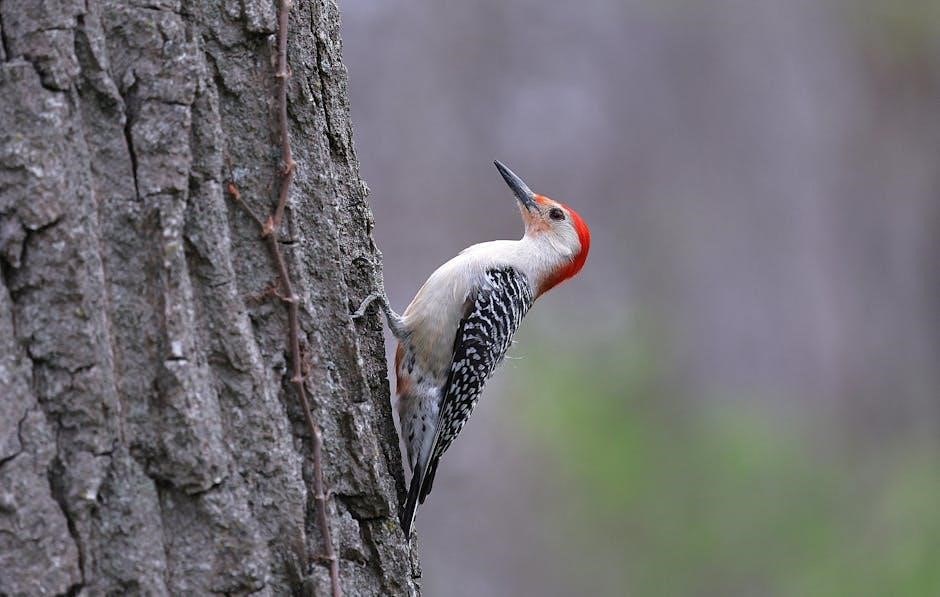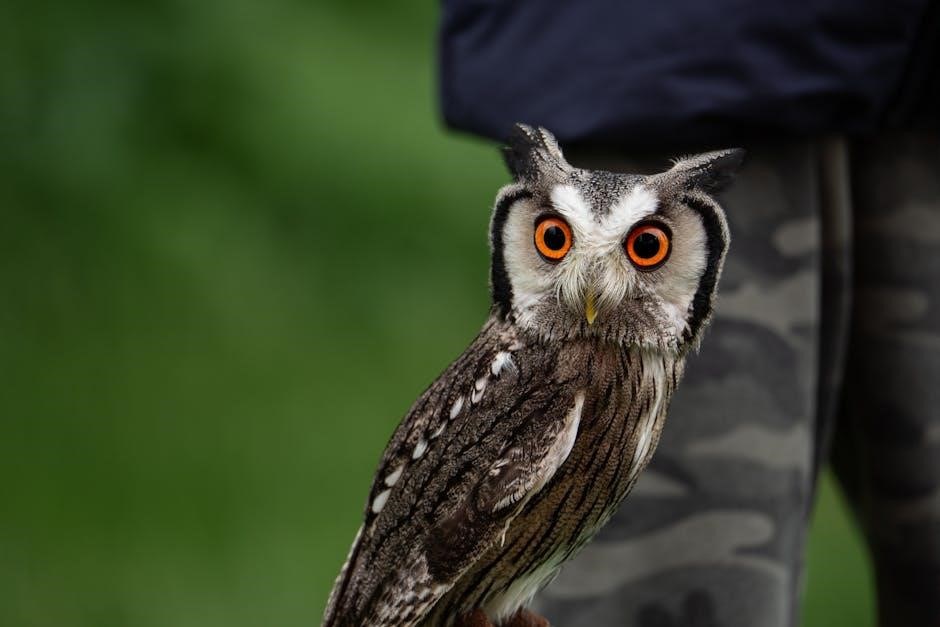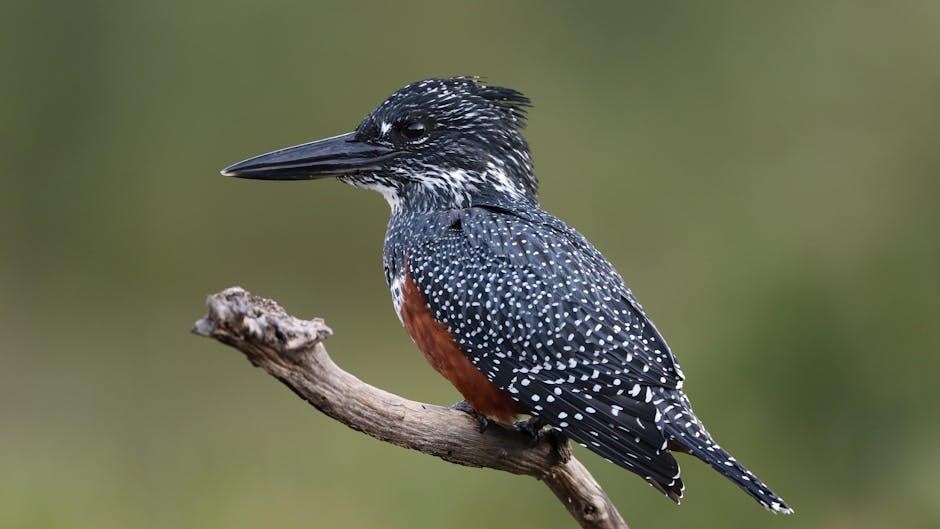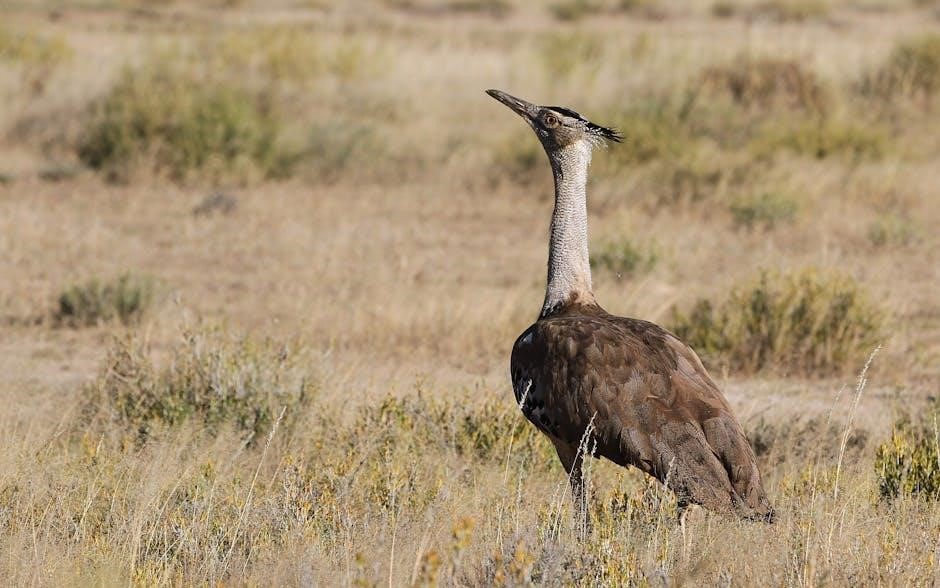Discover the ultimate bird-watching companion with Jack Griggs’ comprehensive guide‚ featuring a revolutionary identification system‚ detailed species insights‚ and user-friendly design for enthusiasts of all levels.
1.1 Overview of the Guide
Jack Griggs’ Bird Guide is a comprehensive resource designed for bird enthusiasts‚ offering detailed insights into North America’s avifauna. The guide features a revolutionary identification system based on feeding behaviors and field markings‚ making it easier for users to recognize species. With coverage of over 800 bird species‚ it provides extensive information on habitats‚ migratory patterns‚ and nesting habits. The guide is structured to cater to both novice and experienced birders‚ ensuring accessibility and depth. Its user-friendly design includes high-quality illustrations and a well-organized format‚ enhancing the learning experience. Griggs’ work is praised for its educational value and practical applications‚ making it an essential tool for anyone interested in bird watching and conservation efforts. This guide serves as a testament to Griggs’ dedication to ornithology and his commitment to fostering a deeper understanding of birds.
1.2 Importance of Bird Watching
Bird watching is more than a hobby; it’s a gateway to understanding ecosystems and promoting conservation. By observing birds‚ enthusiasts gain insights into environmental health‚ as birds serve as indicators of habitat quality. This activity fosters a deeper connection with nature‚ encouraging stewardship and sustainability. Bird watching also contributes to scientific research‚ with data collected by enthusiasts aiding in species preservation efforts. Griggs’ guide emphasizes the role of birders in monitoring populations and supporting conservation initiatives. Additionally‚ bird watching promotes mental well-being and community engagement‚ creating a network of like-minded individuals passionate about wildlife. Through education and advocacy‚ bird watching inspires collective action to protect avian diversity and their habitats‚ highlighting its significance beyond mere recreation.

About the Author
Renowned ornithologist Jack Griggs brings extensive expertise in bird studies‚ offering detailed insights and comprehensive guides that empower enthusiasts and professionals alike in understanding avian diversity and behavior.
2.1 Background of Jack Griggs
Jack Griggs‚ a distinguished ornithologist‚ has dedicated his career to bird conservation and education. With a deep passion for avian studies‚ he has authored several influential field guides‚ including All the Birds of North America‚ which revolutionized bird identification through innovative systems. His work emphasizes feeding behaviors and field markings‚ making it accessible to both novice and experienced birders. Griggs’ collaborations with organizations like the American Bird Conservancy highlight his commitment to conservation efforts. His guides are celebrated for their comprehensive coverage and user-friendly design‚ ensuring that enthusiasts can easily identify and learn about bird species across North America.

2.2 Contributions to Ornithology
Jack Griggs has made significant contributions to ornithology through his groundbreaking field guides and educational resources. His work has bridged the gap between scientific research and public engagement‚ making bird identification and conservation accessible to a broader audience. Griggs’ innovative approach to bird study‚ particularly his focus on feeding behaviors and migratory patterns‚ has set new standards in the field. He has collaborated with renowned organizations like the American Bird Conservancy‚ ensuring his guides are both comprehensive and authoritative. His efforts have inspired a new generation of birders and researchers‚ fostering a deeper appreciation for avian diversity and conservation efforts across North America.

Key Features of the Guide
This guide offers a revolutionary identification system‚ comprehensive species coverage‚ and a user-friendly design‚ making it an essential tool for bird enthusiasts. It includes tips for backyard birding and conservation.
3.1 Revolutionary Identification System
Jack Griggs’ guide introduces a groundbreaking identification system‚ focusing on feeding behaviors and field markings. This innovative approach simplifies bird identification‚ making it accessible to all skill levels. By organizing species based on observable behaviors and distinctive physical traits‚ the guide reduces confusion and enhances accuracy. The system is complemented by detailed illustrations and clear descriptions‚ ensuring users can quickly pinpoint species in the field. This method is particularly effective for beginners‚ as it emphasizes easily noticeable characteristics. The guide also incorporates migratory patterns‚ helping users understand seasonal variations. Its revolutionary approach has set a new standard in bird identification‚ making it an indispensable resource for enthusiasts and researchers alike. This system is a testament to Griggs’ deep understanding of ornithology and his commitment to advancing birding knowledge.
3.2 Comprehensive Species Coverage
Jack Griggs’ guide offers an extensive overview of North American bird species‚ ensuring every birdwatcher can identify and learn about the region’s diverse avifauna. The guide covers over 800 species‚ including both common and rare birds‚ with detailed descriptions of their habits‚ habitats‚ and unique characteristics. Regional checklists for Eastern‚ Western‚ and Central North America provide localized insights‚ helping users track species specific to their area. The guide also features high-quality illustrations and range maps‚ enhancing the ability to recognize birds in their natural environments. This comprehensive coverage makes it an invaluable resource for both casual birders and dedicated ornithologists‚ ensuring no species goes unnoticed. The depth of information underscores Griggs’ dedication to creating a complete and accessible birding reference.
3.3 User-Friendly Design
Jackson Griggs’ bird guide is renowned for its intuitive layout and accessibility‚ making it easy for birders of all skill levels to navigate. The PDF format ensures compatibility across devices‚ allowing users to access the guide on smartphones‚ tablets‚ or laptops. Clear headings‚ high-quality images‚ and concise descriptions enable quick identification of species. The revolutionary identification system‚ based on feeding behaviors and field markings‚ simplifies the process of distinguishing similar birds. The guide’s design prioritizes practicality‚ with features like regional checklists and range maps to help users track species in their area. This user-friendly approach ensures that the guide is both a valuable resource and a pleasure to use‚ whether in the field or at home. Its modern design and accessibility make it a standout choice for bird enthusiasts worldwide.

Regional Focus
The guide covers bird species across North America‚ focusing on Eastern‚ Western‚ and Central regions‚ ensuring comprehensive coverage for birders in diverse habitats and ecosystems.
4.1 Eastern North America
Eastern North America is a hotspot for bird diversity‚ with its lush forests‚ wetlands‚ and coastal areas attracting migratory and resident species. Jack Griggs’ guide provides detailed insights into the region’s avifauna‚ highlighting species like the American Robin‚ Blue Jay‚ and Hummingbirds. The guide’s revolutionary identification system helps enthusiasts spot birds based on feeding behaviors and field markings‚ making it easier to distinguish between similar species. Additionally‚ the guide covers migratory patterns‚ such as the spring and fall migrations‚ which bring a wide variety of birds to the region. Users can learn about nesting habits‚ seasonal changes‚ and conservation efforts specific to Eastern North America‚ enhancing their bird-watching experiences.
4.2 Western North America
Western North America‚ with its vast deserts‚ rugged mountains‚ and Pacific coastline‚ is home to a unique array of bird species. Jack Griggs’ guide meticulously covers the region‚ focusing on iconic birds like the California Condor‚ Anna’s Hummingbird‚ and Western Tanager. The guide’s revolutionary identification system helps birders distinguish species based on plumage‚ songs‚ and habitat preferences. It also explores migratory patterns‚ such as the Pacific Flyway‚ which brings millions of birds to the region each year. Users will find detailed insights into the breeding habits of western species and their adaptation to diverse ecosystems. The guide’s comprehensive coverage ensures that both novice and experienced birders can deepen their understanding of Western North America’s avifauna‚ making it an indispensable tool for any bird-watching adventure in the region.
4.3 Central North America
Central North America‚ encompassing the Great Plains‚ Midwest‚ and southern regions‚ boasts a rich diversity of birdlife. Jack Griggs’ guide provides in-depth coverage of species like the Northern Cardinal‚ American Robin‚ and Red-winged Blackbird. The region’s unique blend of grasslands‚ forests‚ and wetlands supports a wide range of habitats‚ attracting both migratory and resident birds. The guide’s detailed field markings and feeding behavior insights help identify species such as the Sandhill Crane and Great Egret. Additionally‚ it highlights the importance of migratory stopovers‚ like the Mississippi River Valley‚ for waterfowl and songbirds. With its user-friendly design‚ the guide is an essential resource for birders exploring Central North America’s vibrant avifauna‚ offering practical tips for spotting and understanding the region’s bird populations.

Species Identification
Juan Griggs’ guide introduces a revolutionary system for identifying bird species‚ focusing on feeding behaviors‚ field markings‚ and migratory patterns to enhance accuracy and ease for birders.
5.1 Feeding Behaviors
Jack Griggs’ guide emphasizes the importance of feeding behaviors in bird identification‚ highlighting how different species interact with their environment to find food. By observing whether birds forage on the ground‚ in trees‚ or in flight‚ enthusiasts can narrow down identifications. For example‚ ground-foraging birds like sparrows and finches often search for seeds and insects‚ while tree-dwelling species such as warblers and woodpeckers focus on nectar‚ sap‚ or insects in foliage. The guide also explores how feeding behaviors vary by season‚ with migratory birds adapting to new food sources. This section provides practical tips for backyard birding‚ such as selecting seed types to attract specific species‚ making it a valuable resource for both beginners and experienced birders.
5.2 Field Markings
Jack Griggs’ guide places a strong emphasis on field markings as a critical tool for bird identification. These distinctive physical features‚ such as plumage patterns‚ beak shapes‚ and coloration‚ help birders distinguish between similar species. The guide highlights key markings like the white eye ring of the American Robin or the red cap of the Pileated Woodpecker. By focusing on these details‚ enthusiasts can make accurate identifications in the field. Griggs also notes how markings may vary by age‚ sex‚ or season‚ ensuring a comprehensive understanding. This section is particularly valuable for beginners‚ as it breaks down complex characteristics into easily recognizable traits‚ making bird identification more accessible and enjoyable for all skill levels. The guide’s detailed illustrations further enhance the clarity of these field markings‚ ensuring a reliable reference for birders.
5.3 Migratory Patterns
Jack Griggs’ guide provides an in-depth exploration of migratory patterns‚ essential for tracking birds throughout the year. It details the seasonal movements of species‚ highlighting key stopover points and flight routes across North America. The guide emphasizes how understanding these patterns aids in predicting when and where specific birds can be observed. For example‚ it notes the long-distance journeys of warblers and the altitudinal migrations of mountain species. Griggs also discusses how climate change influences these patterns‚ offering insights into shifting migration timings. This section is invaluable for birders aiming to maximize their sightings and appreciate the dynamic nature of bird movements. By combining historical data with modern observations‚ the guide offers a comprehensive view of bird migration‚ enhancing the reader’s ability to connect with these amazing journeys.

Behavioral Insights
Explore the fascinating behaviors of birds‚ including nesting habits‚ social interactions‚ and seasonal adaptations‚ offering deeper connections with these creatures and enhancing your birding experiences.
6.1 Nesting Habits
Nesting habits are a critical aspect of bird behavior‚ revealing their reproductive strategies and habitat preferences. Jack Griggs’ guide details how birds construct nests‚ from intricate cups to cavity nesting‚ providing insights into their life cycles. Readers learn about the materials used‚ nesting sites‚ and the timing of breeding seasons. The guide also highlights how environmental factors influence nesting success‚ offering a deeper understanding of birds’ adaptability. By studying these habits‚ birders can better appreciate the challenges and triumphs of avian reproduction‚ making the guide an invaluable resource for enthusiasts seeking to connect with nature’s wonders. This section is a cornerstone for anyone eager to explore the intimate lives of birds and their nesting behaviors.
6.2 Social Behaviors
Birds exhibit a wide range of social behaviors‚ from flocking to cooperative breeding‚ which are essential for survival and reproduction. Jack Griggs’ guide explores these interactions‚ such as communal foraging‚ migratory groupings‚ and territorial displays. The text highlights how certain species‚ like sandpipers‚ migrate in large flocks‚ while others‚ such as bluebirds‚ form loose associations during breeding seasons. Communication plays a key role‚ with songs and calls serving as vital tools for mating‚ warning calls‚ and maintaining social bonds. Griggs also delves into unique behaviors like mobbing predators and cooperative nesting‚ offering insights into the complex social dynamics of birds. This section enriches readers’ understanding of avian sociology‚ making it easier to interpret and appreciate these interactions in the field.
6.3 Seasonal Changes
Seasonal changes significantly influence bird behaviors‚ habitats‚ and migration patterns. Jack Griggs’ guide details how birds adapt to these shifts‚ such as migratory movements‚ breeding cycles‚ and plumage changes. For instance‚ waterfowl are more abundant in wintering grounds‚ while songbirds thrive during spring migrations. Feeding behaviors also vary‚ with seed-eating birds dominating in colder months and insectivores flourishing in warmer seasons. Griggs’ insights help birders understand these dynamic changes‚ enabling better identification and observation. The guide highlights regional variations‚ ensuring readers can track species throughout the year. By exploring these seasonal patterns‚ birders gain a deeper appreciation of avian life cycles and the importance of timing in bird watching. This section is invaluable for enthusiasts seeking to maximize their birding experiences across different times of the year.

Practical Applications
Jack Griggs’ guide offers practical tips for backyard birding‚ conservation efforts‚ and engaging with the birding community‚ enhancing your bird-watching experience with actionable insights.
7.1 Backyard Birding Tips
Jack Griggs’ guide provides essential tips for backyard birding‚ such as optimizing feeder placement‚ maintaining water sources‚ and planting native vegetation to attract diverse species. It emphasizes the importance of understanding seasonal bird behaviors and creating habitats that support local wildlife. The guide also offers advice on setting up bird-friendly environments‚ including nest boxes and shrubs for shelter. Additionally‚ it highlights the value of keeping a sighting journal and engaging with the birding community for shared learning. These practical strategies help enthusiasts transform their yards into thriving bird sanctuaries‚ enhancing both bird diversity and personal enjoyment. Griggs’ insights make backyard birding accessible and rewarding for all skill levels.
7.2 Conservation Efforts
Jack Griggs’ guide emphasizes the critical role of conservation in protecting bird populations. It highlights the importance of sustainable practices‚ such as reducing habitat destruction and mitigating climate change impacts. The guide advocates for supporting organizations like the American Bird Conservancy‚ which works to protect habitats and advocate for bird-friendly policies. Griggs also stresses the value of citizen science programs‚ where birders can contribute to research and monitoring efforts. By promoting eco-friendly gardening and reducing window collisions‚ individuals can make a significant difference. The guide inspires readers to take action‚ ensuring that future generations can enjoy the beauty and diversity of birds. Conservation efforts are woven into every aspect of the guide‚ making it a powerful tool for environmental stewardship.
7.3 Engaging the Birding Community
Jack Griggs’ guide encourages birders to connect and share their passion for birding. It provides tips on joining local birding clubs‚ participating in citizen science projects‚ and attending birding festivals. The guide highlights the importance of collaboration‚ such as sharing sightings through online platforms and contributing to bird counts. Griggs also emphasizes the value of mentorship‚ urging experienced birders to guide newcomers. By fostering a sense of community‚ the guide helps birders build lasting connections and gain deeper insights into bird behavior and identification. Whether through social media groups or local meetups‚ Griggs’ guide inspires birders to engage‚ learn‚ and grow together‚ making birding a rewarding and collective experience for everyone involved.

Digital Availability
Jack Griggs’ bird guide is available in PDF format‚ ensuring accessibility across devices like smartphones‚ tablets‚ and computers. Its digital format allows for easy zooming and searching.
8.1 Benefits of PDF Format
The PDF format of Jack Griggs’ bird guide offers numerous advantages. It ensures high-quality images and crisp text‚ essential for detailed bird identification. The PDF is lightweight‚ making it easy to store on devices without consuming excessive memory. Users can quickly navigate through sections using bookmarks and hyperlinks‚ enhancing accessibility. Additionally‚ PDFs are universally compatible‚ allowing seamless viewing across various operating systems and devices. The format also preserves the guide’s layout and design‚ maintaining its professional and visually appealing structure. This ensures an optimal reading experience‚ whether on a smartphone‚ tablet‚ or computer. Furthermore‚ the PDF can be easily shared and accessed offline‚ making it a practical choice for birders in remote areas with limited internet connectivity. These features collectively make the PDF version an indispensable tool for modern bird enthusiasts.
8.2 Accessibility Across Devices
Jack Griggs’ bird guide in PDF format is designed for seamless accessibility across all devices. Whether using a smartphone‚ tablet‚ or desktop‚ the guide adapts perfectly to different screen sizes‚ ensuring readability and ease of use. The PDF’s responsive design allows birders to zoom in on high-resolution images and detailed field markings without losing clarity. This feature is particularly useful for identifying species in the field. Additionally‚ the guide can be accessed on e-readers‚ making it a convenient option for those who prefer lightweight devices. The universal compatibility of PDFs ensures that users can access the guide anywhere‚ anytime‚ without worrying about device restrictions. This versatility makes the guide an essential companion for bird enthusiasts on the go‚ providing uninterrupted access to critical information. The ability to sync the PDF across multiple devices further enhances its accessibility‚ allowing for a consistent and reliable birding experience.
8.3 Compatibility with Modern Readers
Jack Griggs’ bird guide in PDF format is fully compatible with modern readers‚ ensuring a seamless experience for users. The guide is optimized for today’s e-readers‚ tablets‚ and smartphones‚ making it easy to navigate and use. Features like search functionality‚ bookmarks‚ and zoom capabilities enhance accessibility and usability. The PDF format supports interactive elements‚ such as clickable links and high-resolution images‚ which are essential for identifying bird species. Additionally‚ the guide is compatible with assistive technologies like screen readers‚ making it inclusive for all users. The modern design and layout ensure that the content is engaging and easy to digest. Whether you’re using a dedicated e-reader or a mobile app‚ the guide adapts effortlessly‚ providing a consistent and enjoyable reading experience. This compatibility ensures that bird enthusiasts can rely on the guide in any setting.

Impact and Reception
Jack Griggs’ bird guide has significantly influenced birding communities‚ offering a trusted resource for enthusiasts. Its educational value has made it a cornerstone for both beginners and experts.
9.1 Influence on Birding Communities
Jack Griggs’ bird guide has profoundly shaped birding communities by offering a comprehensive and accessible resource. Its innovative approach has empowered enthusiasts‚ fostering a deeper connection with nature and encouraging conservation efforts. The guide’s clear and detailed insights have made bird identification easier‚ enabling more people to engage with ornithology. By bridging the gap between amateur birdwatchers and experts‚ Griggs’ work has strengthened the sense of community within birding circles. This has led to increased participation in local and national birding events‚ creating a ripple effect that promotes environmental awareness and stewardship.
9.2 Educational Value
Jack Griggs’ bird guide is a valuable educational resource‚ offering detailed insights into bird species‚ behaviors‚ and habitats. Its clear and structured approach makes it an excellent tool for both beginners and experienced birders. The guide’s emphasis on feeding behaviors‚ field markings‚ and migratory patterns provides a comprehensive understanding of bird biology. Students and educators alike benefit from its accessible language and high-quality visuals‚ which simplify complex concepts. The guide also encourages hands-on learning through practical tips for backyard birding and conservation efforts. By bridging the gap between theory and practice‚ Griggs’ work has become a cornerstone in birding education‚ inspiring a new generation of ornithologists and nature enthusiasts.
Jack Griggs’ bird guide stands as a testament to comprehensive and accessible birding knowledge. Its revolutionary identification system‚ coupled with detailed species coverage‚ has empowered birders across North America. By blending scientific rigor with user-friendly design‚ the guide has become an indispensable tool for both novices and experts. Its availability in PDF format ensures accessibility‚ making it a modern resource for bird enthusiasts everywhere. Griggs’ work not only advances ornithology but also fosters a deeper appreciation for nature‚ inspiring future generations to explore and protect avian diversity. This guide is a must-have for anyone seeking to enhance their birding experience and contribute to conservation efforts.
